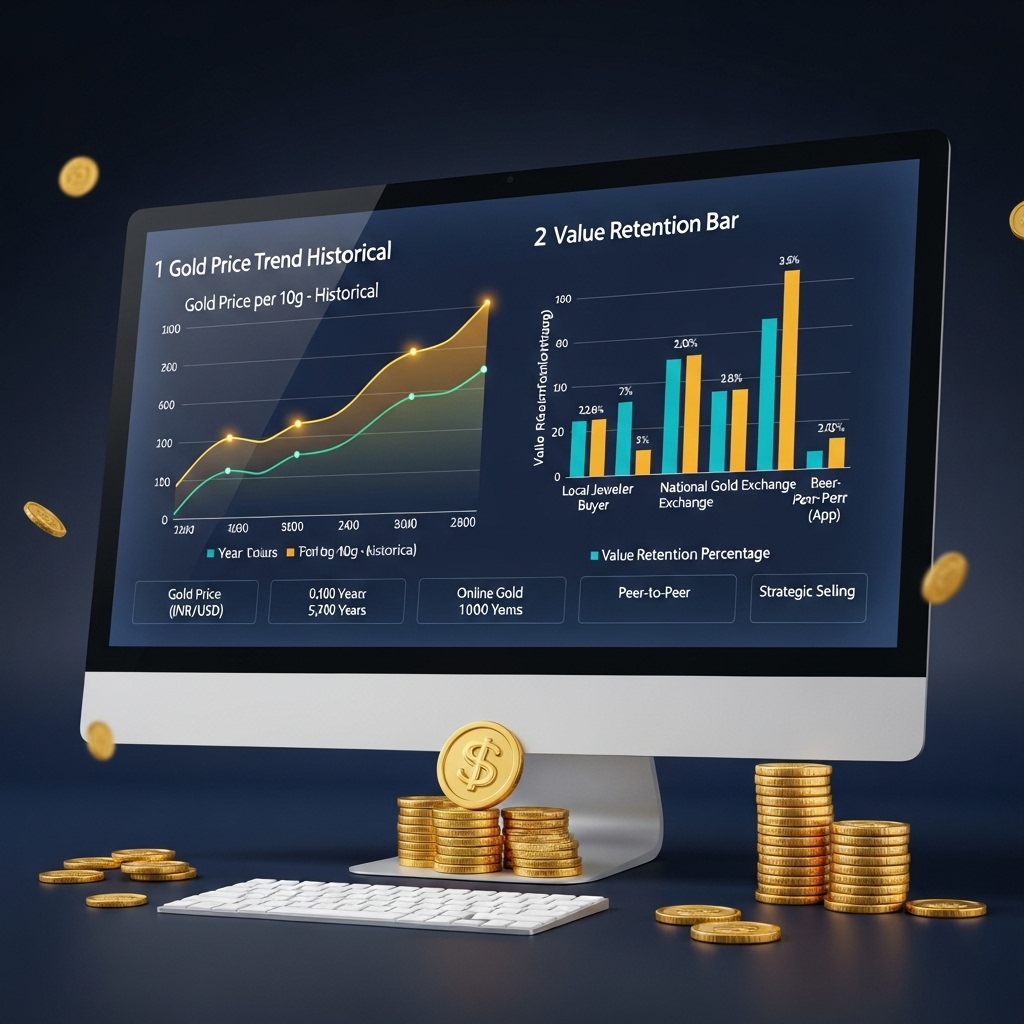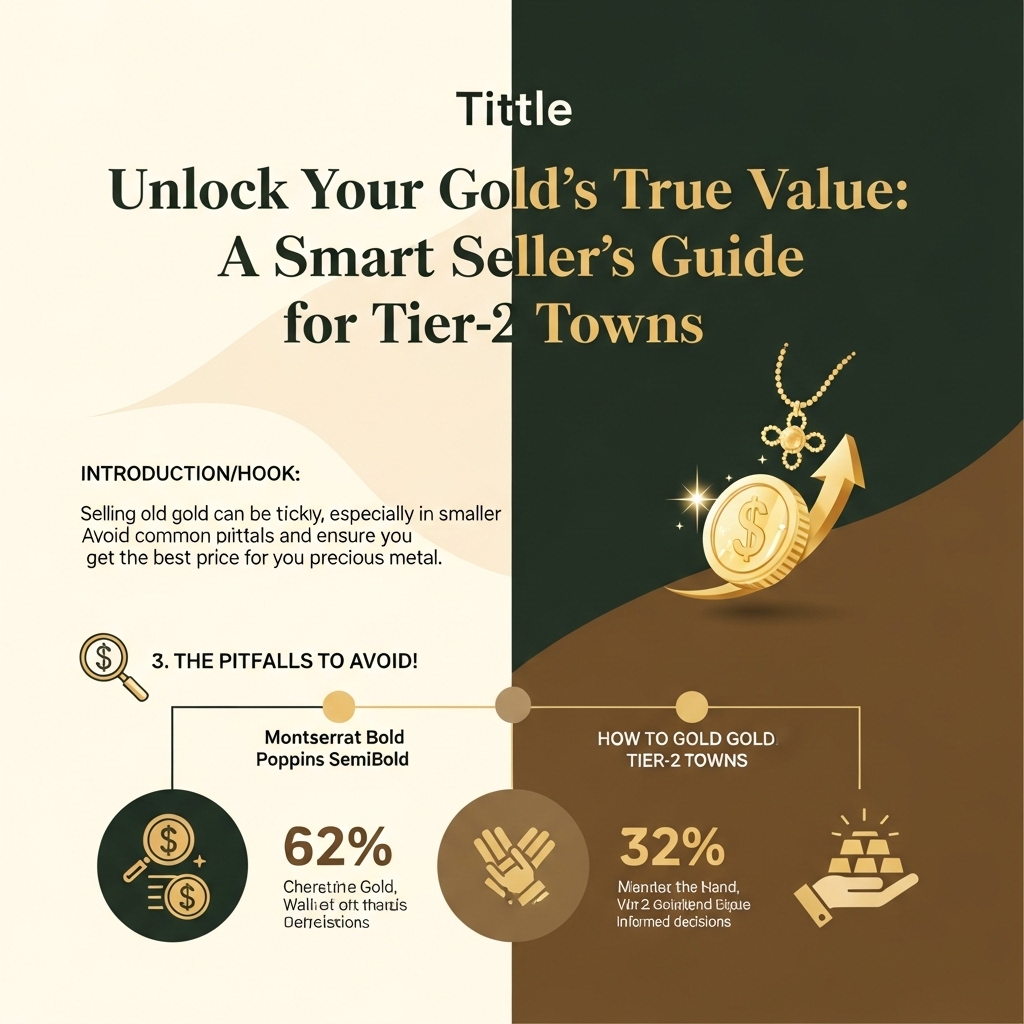Unlocking Value: Your Guide to Selling Old Gold in Tier-2 Towns
With global economic uncertainties and persistent inflation concerns continually pushing gold prices to new highs, astute investors are keenly watching their portfolios, eager to capitalize on their precious metal holdings. While the allure of gold as a safe-haven asset and inflation hedge is well-understood, realizing its full financial potential often hinges on the divestment strategy – a crucial aspect many overlook. For gold investors residing in India’s rapidly developing Tier-2 towns, this process can present unique challenges, making it even more imperative to approach the sale strategically to ensure you don’t inadvertently lose value.
This insightful blog post is meticulously crafted to empower you with the knowledge and tactics needed to navigate the nuances of selling old gold in Tier-2 markets without compromising your investment gains. We will delve into current gold market trends that influence selling prices, illuminate common pitfalls to avoid, and reveal expert strategies for identifying trustworthy buyers and negotiating optimal rates. Our goal is to equip you with the practical steps to not only understand the true worth of your gold but also to confidently execute a sale that maximizes your financial returns, ensuring your gold investment genuinely contributes to your overall wealth-building objectives.
Gold Market Analysis and Key Insights
The perception and utility of gold in Tier-2 towns are distinctly different from metropolitan centers; it’s often viewed primarily as a robust financial asset rather than just an ornament. This deeply ingrained cultural and economic function makes understanding local market dynamics crucial for anyone looking to sell or invest in gold.
Localized Market Dynamics
In Tier-2 markets, transactions are heavily influenced by long-standing relationships and trust with local jewelers. The immediate need for liquidity, coupled with a preference for tangible assets and less access to complex financial instruments, drives consistent local demand for physical gold. This inherent trust often outweighs the pursuit of marginally higher returns from less familiar online or larger-city buyers.
Gold as a Strategic Investment
Current global gold market trends underscore its enduring appeal as a safe-haven asset. Driven by persistent geopolitical uncertainties, rising inflationary pressures, and a search for value preservation amidst economic fluctuations, gold prices have shown remarkable resilience. Data from the past decade reveals a consistent upward trajectory, reinforcing gold’s role as a formidable long-term investment that hedges against currency devaluation and stock market volatility.
Investment Benefits and Considerations: Gold offers unparalleled liquidity, making it easily convertible to cash when needed, a significant advantage in areas with less diversified financial ecosystems. It acts as a critical portfolio diversifier, especially during periods of market turmoil. However, investors must consider the practicalities: secure storage, the importance of purity verification (BIS hallmarking is vital), and potential deductions for making charges or impurities when selling old gold, which can slightly reduce the net realized value.
Expert Recommendations: To maximize returns from gold as an investment, experts advise meticulous purity verification before any transaction. It’s crucial to compare offers from multiple trusted local buyers and fully comprehend the breakdown of the selling price, including any deductions. For optimal capital appreciation, holding gold through several economic cycles (long-term) is generally recommended, solidifying its status as a reliable asset for wealth preservation.

Gold Investment Strategies and Options
After successfully selling your old gold, strategic reinvestment is key to preserving and growing your wealth. Gold remains a powerful asset, offering diversification and a hedge against inflation and economic uncertainty. Understanding your options is crucial.
Investment Options & Strategies:
1. Physical Gold: Reinvesting in new jewelry, coins, or bars. While tangible, be mindful of making charges, purity concerns, and storage risks. This option is best for sentimental value or specific cultural needs.
2. Digital Gold: Allows purchasing gold in fractional amounts online, with guaranteed purity and no storage hassles. Convenient for smaller investments and immediate transactions.
3. Gold Exchange Traded Funds (ETFs): Traded on stock exchanges, Gold ETFs track physical gold prices, offering liquidity and avoiding storage risks. A demat account is required.
4. Sovereign Gold Bonds (SGBs): Issued by the government, SGBs offer annual interest, are tax-efficient on maturity, and eliminate storage concerns. They combine gold appreciation with fixed income, making them ideal for long-term investors (8-year maturity).
Comparison & Risk Assessment:
Physical gold provides immediate liquidity but carries storage risks, purity verification issues, and potential making charges upon repurchase. Digital and paper gold (ETFs, SGBs) offer purity guarantees, lower transaction costs (excluding brokerage for ETFs), and no storage worries. SGBs are particularly appealing for their interest payments and tax benefits, positioning them as a superior long-term investment vehicle compared to physical gold for pure investment.
Gold’s primary risk is price volatility, influenced by global economic conditions and currency fluctuations. Diversify your portfolio by allocating a portion (e.g., 5-15%) to gold, leveraging its safe-haven qualities against market downturns, while balancing with other asset classes like equities or fixed income.
Market Timing:
Monitor gold price trends. Consider selling your existing gold when prices are high to maximize returns. For reinvestment, look for price dips or utilize systematic investment plans (SIPs) in ETFs or digital gold to average out costs over time. Global economic instability often drives gold prices upward, offering opportune times for selling or holding.
Market Performance and Outlook
Selling old gold in Tier-2 towns is directly influenced by broader gold market dynamics and local economic realities. Historically, gold has served as a stable store of value, often appreciating during economic uncertainty. This historical resilience is a key driver for individuals in Tier-2 cities to consider selling when needing liquidity. Current market conditions show fluctuating gold prices, heavily impacted by global inflation concerns and central bank monetary policies. While interest rate hikes can temper gold’s appeal, geopolitical instability frequently drives it upwards as a safe-haven asset.
The future outlook for gold remains cautiously optimistic. Predictions suggest continued volatility, but a general upward trend is anticipated as long as inflation persists and global economic uncertainty lingers. For Tier-2 towns, this translates to potentially better selling prices, but also a need for sellers to be informed and patient. Key economic factors influencing prices include the strength of the US dollar (inverse relationship), global demand from industrial and jewelry sectors, and sovereign gold reserves. Locally, economic health within Tier-2 towns, impacting consumer spending power and the availability of alternative investment avenues, also plays a role. Effectively navigating these factors without losing value requires understanding these interconnected forces.
Frequently Asked Questions About Gold Investment
Where are the best places to sell old gold in Tier-2 towns?
Opt for well-known local jewellers or national chain branches. Reputable online gold buyers with secure doorstep services are also an option, provided they offer transparency and have a strong verifiable presence and customer reviews.
How can I ensure I get fair market value for my gold?
Check daily 24K gold rates online. Insist on a computerized XRF purity test over less accurate methods. Compare net offers from 2-3 buyers, understanding all deductions (impurities, melting loss, making charges) before finalizing your sale.
What documents are needed to sell old gold?
A government-issued photo ID (Aadhaar, PAN card) is essential for KYC compliance. Original purchase bills are highly recommended; they can help prove legitimate ownership and sometimes assist in establishing the gold’s initial purity.
Is it safer to sell gold online or to a local shop in Tier-2 towns?
Local shops provide immediate cash and direct interaction. Online platforms can be competitive but require thorough vetting for reputation and security. Choose verified online buyers with clear processes and good reviews for safety.
How do I verify the purity of my gold before selling?
Demand an XRF (X-ray fluorescence) machine test from the buyer; it’s the most accurate and non-destructive method. Always be present during testing and avoid dealers who rely solely on less precise acid tests or visual inspection.

Final Thoughts on Gold Investment
To conclude, selling your old gold in Tier-2 towns without compromising its true value is entirely achievable. The key takeaways are clear: prioritize thorough research, understand your gold’s purity and current market rates, and always seek multiple competitive offers from trusted local jewellers or reliable online platforms. Remember, an informed seller is an empowered seller.
Gold remains an indispensable asset for wealth preservation and portfolio diversification, offering stability in volatile times. Our final recommendation is to view gold not just as a purchase, but as a strategic long-term investment that includes smart liquidation. Apply these proven strategies, and you’ll always command the best price for your precious metal. Take control of your gold investments today!